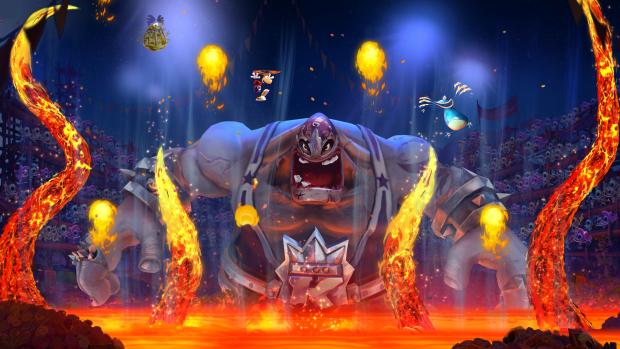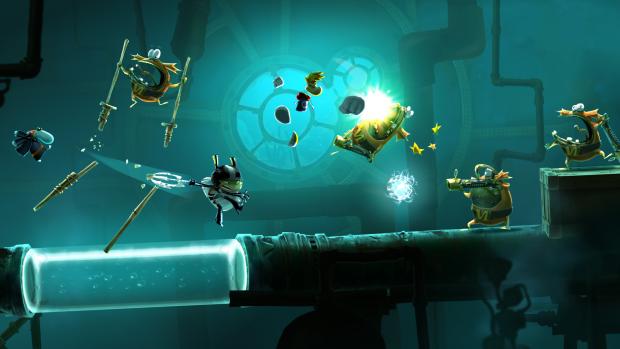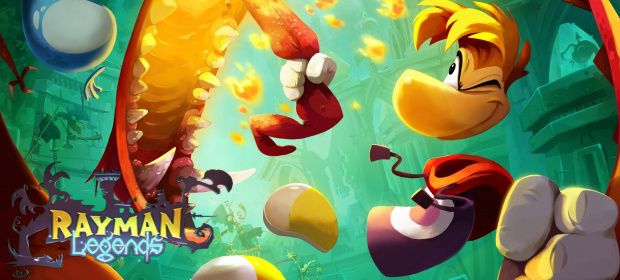Rayman Legends isn’t perfect, let’s get that out of the way right now. Having experienced Origins, it’s easy to assume that an iteration upon that style will have more anticipation than any game can ever live up to. Newcomers to Rayman and his hilarious, daftly animated limbless persona will be overcome with emotions they may not have experienced when playing video games for quite some time, because the glorious colours bleed into the player’s eyes like no other game: this is special, make no mistake.
At its core, it’s a simple platform game, but the level design is out of this world, which, combined with the stunning look and audio design, means that the entire game is elevated to a platform of grace, because a lot of the actual gameplay becomes about rhythm and skill. That said, while the level design in places easily eclipses that of Origins, there is also more of an emphasis on exploration.
Of course, speed-runs are possible, but the first time through any individual level is all about finding the lost Teensies, who are hidden throughout the environment, either directly or in hidden doors (just like in Origins). And that’s really all there is to the story – the Teensies have been captured by a group of evil Wizards, hidden inside paintings that you jump in to and explore. The pattern is pretty simple, too: you’ll go through a series of progressively more challenging levels, before having a chase level (similar to Origins’ treasure chest stages, but instead chasing an evil Wizard who has captured a Teensie), a boss fight, then a music level.

The bosses themselves are well thought out and full of personality that oozes from every corner of the screen, but a few of them have the potential to be very frustrating, requiring a high level of precision that isn’t quite offered through the controls. The Luchadore boss took me a healthy amount of attempts, whereas others weren’t so tough. In fairness, however, Legends never really steps into what you’d call “difficult” territory, offering a moderate challenge throughout; at least, not until you add extra players via local-only multiplayer.
You can understand why Ubisoft Montpellier decided to keep the multiplayer local, because in a similar fashion to the New Super Mario Bros. series, adding addition players to the screen becomes an utterly chaotic affair, with players frequently hassling one another and generally getting in each other’s way. In truth, after exploring the local multplayer gameplay, after a while, the decision was simply to play the main levels in single player, and save multiplayer for Kung Foot. Speaking of which, it’s a ludicrous amount of fun to grab three friends and play what equates to Rayman Football. Nothing more than a simple mini-game, time and time again you’ll find yourself coming back for one quick match – it’s just a shame that this is local play only.
Online multiplayer is catered for via daily and weekly asynchronous challenges. Taking place on maps you’ve already experienced in some form or another, these challenges will be a simple case of collecting a certain amount of Lums in a given time, or making it as far as you can across a never-ending map (think of it like an endless runner game on iOS platforms). All these challenges put you up against your friends list and, of course, the world at large. While it’s no substitute for actually playing with your friends, the execution is faultless, and if Ubisoft support it for the foreseeable future, it will do its job of retaining your interest, and keeping you playing for months to come.
But this is just one of the many new features added for Legends. As you’d expect, the levels are divided up into worlds which revolve around a theme. Personal favourite, “20,000 Lums Under the Sea”, actually invokes a stealth mechanic, where you’ll have to hide from searchlights and such. These levels also include another new addition, Murphy.
Tasked with waking our heroes from their slumbering, restful state, Murphy is a small, green flying creature who can interact with the levels in a way Rayman (or whichever character you’re using at the time) cannot. Having played the Wii U version of Legends, there’s absolutely no question that the decision to go multi-platform must have provided a headache for the team at Ubisoft Montpelllier. With the Nintendo-platform having touch-controls, interaction is actually done via touching the objects that require cutting, moving or otherwise. On the Xbox 360 (and PS3) version these interactions are all actioned via a tap or hold of the B (or Circle) button. Most of the time this works perfectly, however there were occasions where Murphy wasn’t quite up to speed, and in a game that can at times become all about precision, speed and grace, this can cause a real break in the flow, or worse, a death. These incidents are pretty rare, but worth noting, and if you’re able to do so, the Wii U version is definitely the one to go for – though you won’t feel short-changed if you can’t.
Where Origins felt utterly huge at times (indeed, the game just kept on giving), Legends doesn’t feel quite as large. It has 5 worlds, each with 8 levels inside (including the boss, chase and music levels), and a few extras too. Each world has two princess (playable) characters to save, which makes 10, and “Invaded” levels, which are alternate versions of previous levels that are unlocked when certain requirements are met and filled with enemies from other worlds, and even ask you to run in the opposite direction sometimes. While that seems quite generous, I was able to barrel through all the main levels, and thus see the credits roll fairly quickly. Of course, that’s half the story, as there are a grand total of 700 Teensies to save, and given that the maximum you can rescue on any level is 10, that gives an indication of true size.

This falls down slightly, though, because the sixth unlockable bonus world – Living Dead Party, which I wouldn’t dream of spoiling here – requires 400 of the 700 saved in order to unlock, which brings me neatly onto my second major criticism: Back to Origins.
Containing 40 levels from Rayman Origins, this additional world has been repurposed to fit the new gameplay mechanics for Legends. Each level contains hidden Teensies, and Lums now act in the new way (grab the first purple one, and they progressively become purple, instead of a “king” Lum which automatically turns them so), but the trouble is, to anyone who has played Origins extensively, these really don’t feel “new” enough at all. This is compounded by the fact that the easiest way to gain the required number of Teensies for the final bonus world is to play these Origins levels (remember: 10 Teensies per painting, whereas Invaded levels only have 3). The payoff is just about worth the minor grind, but it also serves to show that, in places, Origins was actually a different game, and Legends is in no way lazy. It’s an odd conundrum, because the levels just don’t feel different enough for fans, but it’s also a nice inclusion for newcomers.
A persistent “awesomeness” level runs throughout, and is based on how many trophies you have gathered (platinum, gold, silver and bronze – awarded for completing levels with a set of Lums, or perfecting them), and the Lucky Ticket system (one available on every level, after a set number of Lums are gathered) is a nice addition that amounts to a scratchcard game that gives you new Back to Origins levels, extra Lums and even extra Teensies. There are over 30 playable characters, which are also unlocked through collecting Lums – overall there’s plenty to see and do, including another new feature: Creatures. These are collected through the Lucky Ticket system, and go in their own gallery. Once unlocked, each one will give you either a golden coin or purple Lum every day, so are a nice way to bump up your Lum count.
For all the Back to Origins complaints, the musical levels are the saving grace, and have some of the best execution I’ve ever played in a platformer. They’re astonishing, and are absolutely impossible not to play without smiling from ear to ear. The only problem is that there aren’t enough of them, and (please know that I hate myself for saying this) I’d gladly pay for more via DLC, if that’s what it takes. Replaying them doesn’t really yield any bonus once you’ve grabbed all the Teensies, either. Sure, it’ll add to your overall Lum-count, but they’re so fun you’ll play them not for achievements, or for points – but for the joy they bring and nothing else, and that sums up Rayman Legends rather nicely.
VERDICT: It’s not perfect, no, but it brings such joy to the player that it’s impossible not to fall utterly, head-over-heels in love with it. Aside from online multiplayer, it’s tricky to know just what else Ubisoft Montpellier could have brought to the table here, as there really is such a high level of detail, care and love for their product.
As a difficult second album, Rayman Legends is just one of those things that, no matter how hard you try, it remains a true and pure good. You can scrutinise it to the nth degree, but its charms will always overcome everything in the end, and with enough fresh ideas (whilst borrowing from Origins), Rayman Legends is an absolute must-own game, if only for the wonderful asynchronous multiplayer and incredible music levels.

SUPERB. This is the mark of greatness, only awarded to games that engage us from start to finish. Titles that score 9/10 will have very few problems or negative issues, and will deliver high quality and value for money across all aspects of their design.





